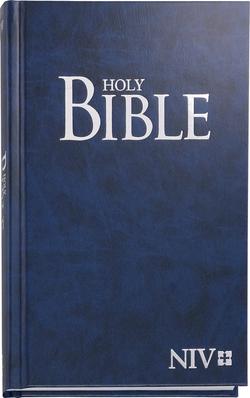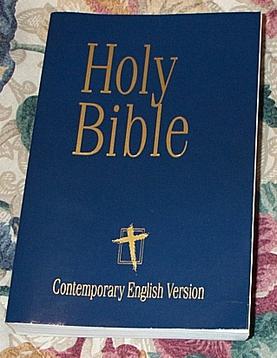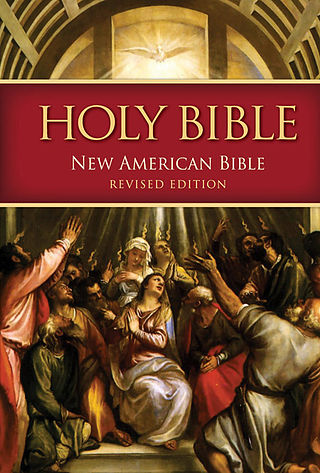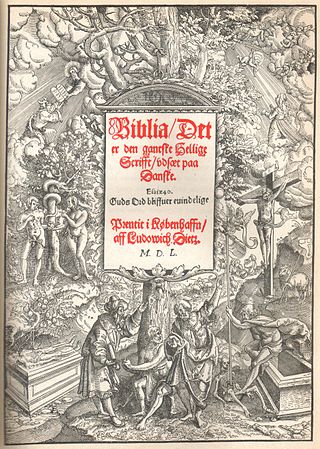
The King James Version (KJV), also the King James Bible (KJB) and the Authorized Version, is an English translation of the Christian Bible for the Church of England, which was commissioned in 1604 and published in 1611, by sponsorship of King James VI and I. The 80 books of the King James Version include 39 books of the Old Testament, an intertestamental section containing 14 books of what Protestants consider the Apocrypha, and the 27 books of the New Testament. Noted for its "majesty of style", the King James Version has been described as one of the most important books in English culture and a driving force in the shaping of the English-speaking world.

The New International Version (NIV) is a translation of the Bible in contemporary English. Published by Biblica, the complete NIV was released in 1978 with major revisions in 1984 and 2011. The NIV relies on recently published critical editions of the original Hebrew and Greek texts.

Today's New International Version (TNIV) is an English translation of the Bible which was developed by the Committee on Bible Translation (CBT). The CBT also developed the New International Version (NIV) in the 1970s. The TNIV is based on the NIV. It is explicitly Protestant like its predecessor; the deuterocanonical books are not part of this translation. The TNIV New Testament was published in March 2002. The complete Bible was published in February 2005. The rights to the text are owned by Biblica. Zondervan published the TNIV in North America. Hodder & Stoughton published the TNIV in the UK and European Union.

The Geneva Bible is one of the most historically significant translations of the Bible into English, preceding the King James Version by 51 years. It was the primary Bible of 16th-century English Protestantism and was used by William Shakespeare, Oliver Cromwell, John Knox, John Donne, and others. It was one of the Bibles taken to America on the Mayflower. The Geneva Bible was used by many English Dissenters, and it was still respected by Oliver Cromwell's soldiers at the time of the English Civil War, in the booklet The Souldiers Pocket Bible.

The Bible has been translated into many languages from the biblical languages of Hebrew, Aramaic, and Greek. As of 2022 all of the Bible has been translated into 724 languages, the New Testament has been translated into an additional 1,617 languages, and smaller portions of the Bible have been translated into 1,248 other languages according to Wycliffe Global Alliance. Thus, at least some portions of the Bible have been translated into 3,589 languages.

The Contemporary English Version or CEV is a translation of the Bible into English, published by the American Bible Society. An anglicized version was produced by the British and Foreign Bible Society, which includes metric measurements for the Commonwealth market.

The Douay–Rheims Bible, also known as the Douay–Rheims Version, Rheims–Douai Bible or Douai Bible, and abbreviated as D–R, DRB, and DRV, is a translation of the Bible from the Latin Vulgate into English made by members of the English College, Douai, in the service of the Catholic Church. The New Testament portion was published in Reims, France, in 1582, in one volume with extensive commentary and notes. The Old Testament portion was published in two volumes twenty-seven years later in 1609 and 1610 by the University of Douai. The first volume, covering Genesis through Job, was published in 1609; the second, covering Psalms to 2 Maccabees plus the three apocrypha books of the Vulgate appendix following the Old Testament was published in 1610. Marginal notes took up the bulk of the volumes and had a strong polemical and patristic character. They offered insights on issues of translation, and on the Hebrew and Greek source texts of the Vulgate.

Wycliffe's Bible is the name now given to a group of Bible translations into Middle English that were made under the direction of English theologian John Wycliffe. They appeared over a period from approximately 1382 to 1395. These Bible translations were the chief inspiration and chief cause of the Lollard movement, a pre-Reformation movement that rejected many of the distinctive teachings of the Catholic Church. In the early Middle Ages, most Western Christians encountered the Bible only in the form of oral versions of scriptures, verses and homilies in Latin. Though relatively few people could read at this time, Wycliffe's idea was to translate the Bible into the vernacular, saying "it helpeth Christian men to study the Gospel in that tongue in which they know best Christ's sentence".
The Holy Bible from Ancient Eastern Manuscripts was published by George M. Lamsa in 1933. It was derived, both Old and New Testaments, from the Syriac Peshitta, the Bible used by the Assyrian Church of the East and other Syriac Christian traditions.

Parts of the Bible have been translated into Welsh since at least the 15th century, but the most widely used translation of the Bible into Welsh for several centuries was the 1588 translation by William Morgan, Y Beibl cyssegr-lan sef Yr Hen Destament, a'r Newydd as revised in 1620. The Beibl Cymraeg Newydd was published in 1988 and revised in 2004. Beibl.net is a translation in colloquial Welsh which was completed in 2013.
The Holy Bible in Modern English, commonly known as the Ferrar Fenton Bible, was an early translation of the Bible into English as spoken and written in the 19th and 20th centuries.
The terms dynamic equivalence and formal equivalence, coined by Eugene Nida, are associated with two dissimilar translation approaches that are employed to achieve different levels of literalness between the source and target text, as evidenced in biblical translation.

John 10 is the tenth chapter of the Gospel of John in the New Testament of the Christian Bible. The author of the book containing this chapter is anonymous, but early Christian tradition uniformly affirmed that John composed this Gospel. This chapter records Jesus' description of himself as the "door of the sheep" and the "Good Shepherd", and contains the only mention of Hanukkah, "the Feast of Dedication", in the New Testament.

The official translation used by the state church, the Evangelical Lutheran Church of Finland, is approved by its Synod. There have been three official translations: Biblia: Se on: Coco Pyhä Ramattu Suomexi (1642), Pyhä Raamattu (1933/1938), and the current one Uusi kirkkoraamattu (1992/2007). The term kirkkoraamattu means that the edition has to be suited for service of worship and other needs of the church.

Sacred Name Bibles are Bible translations that consistently use Hebraic forms of the God of Israel's personal name, instead of its English language translation, in both the Old and New Testaments. Some Bible versions, such as the Jerusalem Bible, employ the name Yahweh, a transliteration of the Hebrew tetragrammaton (YHWH), in the English text of the Old Testament, where traditional English versions have LORD.
The Good News Study Bible is an edition of the Good News Bible with study Bible notes and articles.

The New American Bible Revised Edition (NABRE) is an English-language Catholic translation of the Bible, the first major update in 20 years to the New American Bible (NAB), which was translated by members of the Catholic Biblical Association and originally published in 1970. Released on March 9, 2011, the NABRE consists of the 1986 revision of the NAB New Testament with a fully revised Old Testament approved by the United States Conference of Catholic Bishops in 2010.
Bible translations into Persian have been made since the fourth or fifth century, although few early manuscripts survive. There are both Jewish and Christian translations from the Middle Ages. Complete translations of the Hebrew Bible and Greek New Testament from original languages were first made in the 19th century by Protestant missionaries.

Bible translations in Norway date back to the late 13th century. Since the first spread of Christianity in Norway, numerous translations of the Bible have been published. Translations have appeared in several of the official languages that Norway has had throughout its history, including editions in Old Norse, Danish, and both current standard forms Nynorsk and Bokmål.
The New Testament was first published in Scottish Gaelic in 1767 and the whole Bible was first published in 1801. Prior to these, Gaels in Scotland had used translations into Irish.














